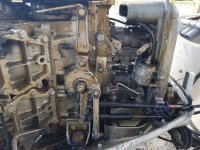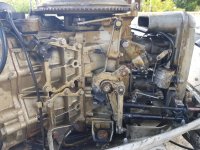seagulljim
Member
I have a 1976 (V4 Crossflow) Evinrude 115 in which I have invested many hours..
I did a routine water pump overhaul a few months back after it stopped pumping. It was a success & went back to pumping as normal.
After this however, issues with a low idle started. RPM was much lower than it should be with the warm up lever right up and the engine would die as the lever was depressed (and if not, at the point of being put into gear).
After much tinkering with throttle cables (as I had taken them out for better access during water pump overhaul) the problems persisted. Sometimes I could get it running adequately running in a tub but as soon as I got it into the water with the extra back pressure the issues were there. Now the difference in back pressure doesn't seem to be making any difference either way.
I thought it may be a carburetor issue so rebuilt them (although upon taking them apart they looked fine).
I finally took it to a mechanic for assistance. He set the timing to the proper specs and adjusted throttle cables. He also repeated basic compression tests etc that I had. The screw that advances the timing is now all the way in. Frustratingly, it seemed to run OK in his tank and would shift into gear without issue.
I got it back in the water and the same problems appeared.
It has:
-Good compression (almost 140 across all cylinders and none of them are dropping out)
-Good spark all round (plugs are also brand new)
-A new fuel filter/pump and internal fuel line (I have tested the fuel flow and everything is in order)
-Rebuilt carburetors
The fuel is also fresh and mixture accurate.
I'm guessing it's something in the fuel system and the water pump overhaul may have been a coincidence but it is odd that the problems started as soon as I had the leg off and back on.
The mechanic seems now to be out of ideas.. as am I.. I've exhausted the troubleshooting ideas offered by the manual.
For what it's worth here is a link to a video of it starting up with the warm up lever up and then eventually dying as it is lowered.
https://www.youtube.com/watch?v=xQNY_RBnano
Any advice would be very much appreciated!
I did a routine water pump overhaul a few months back after it stopped pumping. It was a success & went back to pumping as normal.
After this however, issues with a low idle started. RPM was much lower than it should be with the warm up lever right up and the engine would die as the lever was depressed (and if not, at the point of being put into gear).
After much tinkering with throttle cables (as I had taken them out for better access during water pump overhaul) the problems persisted. Sometimes I could get it running adequately running in a tub but as soon as I got it into the water with the extra back pressure the issues were there. Now the difference in back pressure doesn't seem to be making any difference either way.
I thought it may be a carburetor issue so rebuilt them (although upon taking them apart they looked fine).
I finally took it to a mechanic for assistance. He set the timing to the proper specs and adjusted throttle cables. He also repeated basic compression tests etc that I had. The screw that advances the timing is now all the way in. Frustratingly, it seemed to run OK in his tank and would shift into gear without issue.
I got it back in the water and the same problems appeared.
It has:
-Good compression (almost 140 across all cylinders and none of them are dropping out)
-Good spark all round (plugs are also brand new)
-A new fuel filter/pump and internal fuel line (I have tested the fuel flow and everything is in order)
-Rebuilt carburetors
The fuel is also fresh and mixture accurate.
I'm guessing it's something in the fuel system and the water pump overhaul may have been a coincidence but it is odd that the problems started as soon as I had the leg off and back on.
The mechanic seems now to be out of ideas.. as am I.. I've exhausted the troubleshooting ideas offered by the manual.
For what it's worth here is a link to a video of it starting up with the warm up lever up and then eventually dying as it is lowered.
https://www.youtube.com/watch?v=xQNY_RBnano
Any advice would be very much appreciated!



